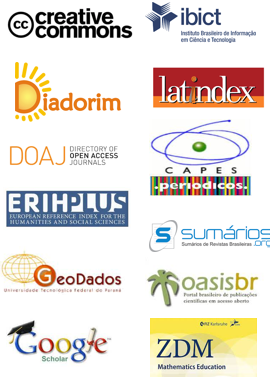Currículo Prescrito para o Ensino de Frações no Ensino Fundamental
DOI:
https://doi.org/10.17921/2176-5634.2021v14n3p365-374Resumo
Resumo
Este artigo apresenta resultados de uma investigação interpretativa que, apoiada em Sacristan, analisa o currículo prescrito para ensinar os significados da representação fracionária dos Números Racionais no Ensino Fundamental. Para tanto, foi realizada uma pesquisa bibliográfica acerca de estudos da área que discutem a temática e uma pesquisa documental das orientações curriculares brasileiras – Parâmetros Curriculares Nacionais – PCN – e Base Nacional Comum Curricular – BNCC – para o ensino de frações no Ensino Fundamental. A partir da análise do currículo prescrito, foi possível identificar, tanto nos PCN como na BNCC, que o estudo sobre fração inicia-se desde muito cedo na vida escolar dos alunos, continuando em toda a educação básica. Nos objetivos e habilidades propostos nos PCN, no eixo Números, nota -se que os introdução da fração ocorre no 2º ciclo, com os significados: quociente, parte – todo e razão, no 3º Ciclo esses significados são retomados e acrescidos da ideia de operador. Já na BNCC, é prevista o desenvolvimento de habilidades envolvendo os significados da fração a partir do 5º Ano relacionando, sobretudo a ideia de parte–todo. No 6º Ano é acrescido o significado quociente, no 7º Ano, além do significado parte-todo e quociente são propostas habilidades envolvendo o conceito de operador e razão. Já nos demais Anos/ Ciclos tratados nos dois documentos não encontramos nenhuma outra referência aos significados da fração.
Palavras-chave: Educação Matemática. Parâmetros Curriculares Nacionais. Base Nacional Comum Curricular. Ensino de Frações. Ensino Fundamental.
Abstract
This article presents results of an interpretative investigation that, supported by Sacristan, analyzes the prescribed curriculum to teach the meanings of fractional representation of Rational Numbers in Elementary Education. For this purpose, a bibliographic research was carried out on studies in the area that discuss the theme and a documentary research of the Brazilian curricular guidelines - National Curriculum Parameters - PCN - and Common National Curricular Base - BNCC - for the teaching of fractions in Elementary Education. From the analysis of the prescribed curriculum, it was possible to identify, both in the PCN and in the BNCC, that the study on fraction starts very early in the students' school life, continuing throughout basic education. In the objectives and skills proposed in the PCN, in the Numbers axis, it is noted that the introduction of the fraction occurs in the 2nd cycle, with the meanings: quotient, part - whole and reason, in the 3rd Cycle these meanings are taken up and added to the idea of operator. At BNCC, the development of skills involving the meanings of the fraction is expected from the 5th year on, relating, above all, the idea of part-whole. In the 6th year, the quotient meaning is added, in the 7th year, in addition to the part-whole and quotient meaning, skills are proposed involving the concept of operator and reason. In the other Years / Cycles dealt with in the two documents, we found no other reference to the meanings of the fraction.
Keywords: Mathematical Education. National Curriculum Parameters. Common National Curricular Base. Teaching Fractions. Elementary School.


